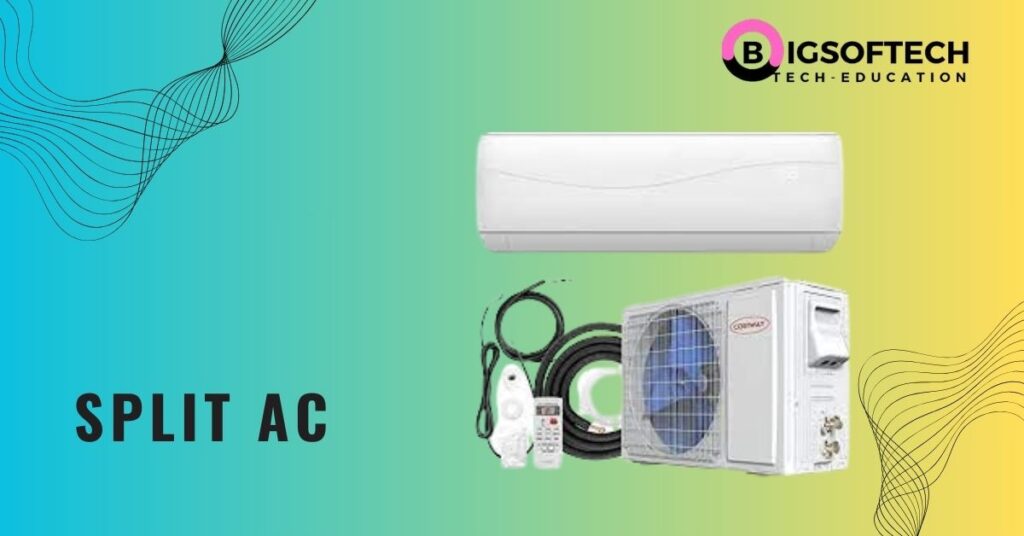In this post, we’ll break down how split ac system air conditioners function and highlight when they’re most useful. Our goal is to make it simple for you to decide whether they’re the right choice for keeping your home or office cool.
What is Split AC System?
A split air conditioner, commonly known as a split AC System, is a cooling system comprising two main units: the indoor and outdoor units. The indoor unit contains the evaporator coil, blower fan, air filter, and remote control responsible for absorbing indoor heat and distributing cooled air. The outdoor unit houses the compressor, condenser coil, expansion valve, and refrigerant, releasing absorbed heat outside. Split ACs are popular for their energy efficiency, quiet operation, and modern design, making them a preferred choice for cooling homes and commercial spaces.
Components of Split Air Conditioner System
- Indoor Unit:
- Evaporator Coil: the evaporator coil is a vital component in the split air conditioner. The evaporator is responsible for absorbing heat from the indoor air; it facilitates the exchange of warm air for cool air.
- Blower Fan: The blower fan circulates the cooled air throughout the room, ensuring a comfortable temperature after the evaporator coil absorbs the heat.
- Air Filter: This component helps in maintaining indoor air quality by trapping dust, pollen, and other particles. Regular cleaning or replacement of filters is essential for optimal performance.
- Remote Control: Providing convenience, the remote control allows users to adjust settings such as temperature, fan speed, and mode from a distance.
- Outdoor Unit:
- Compressor: Acting as the heart of the air conditioner, the compressor is responsible for pressurizing the refrigerant, converting it from a low-pressure gas to a high-pressure gas.
- Condenser Coil: Located in the outdoor unit, the condenser coil releases the heat absorbed from the indoor air into the external environment.
- Expansion Valve: Regulating the flow of refrigerant between the indoor and outdoor units, the expansion valve ensures an efficient cooling process.
- Refrigerant: This chemical substance circulates between the indoor and outdoor units, undergoing phase changes to absorb and release heat.
- Drain line: The drain line removes condensation from the indoor unit and sends it outside.
How does split AC System works
- Indoor Unit Operation:
- The indoor unit contains an evaporator coil that cools the air by absorbing heat from the indoor environment.
- The blower fan circulates the cooled air into the room, creating a comfortable temperature.
- Refrigerant Circulation:
- In Split AC system the refrigerant, a chemical substance with excellent heat-absorbing properties, circulates between the indoor and outdoor units through a set of pipes.
- Compressor Action:
- The compressor, located in the outdoor unit, pressurizes the refrigerant, converting it from a low-pressure gas to a high-pressure, high-temperature gas.
- Heat Release at Outdoor Unit:
- The high-pressure, high-temperature refrigerant flows to the outdoor condenser coil, where it releases the absorbed heat to the external environment.
- Expansion Valve Function:
- The refrigerant, now in a low-pressure, low-temperature state, passes through an expansion valve, regulating its flow back into the indoor unit.
- Evaporation and cooling:
- As the refrigerant returns to the indoor evaporator coil, it absorbs heat from the indoor air, evaporating into a low-pressure gas.
- This process of absorbing heat causes the air around the coil to cool, and the cycle repeats.
- Air Filtration:
- The indoor unit is equipped with an air filter, which traps dust, allergens, and particles, contributing to improved indoor air quality.
- Zoning Capability:
- One of the distinctive features of a split AC is its ability to cool specific zones independently, controlled by the user through the remote control.
Advantages of Split Air Conditioners
- Energy Efficiency:
- Split ACs are famous for their energy efficiency, often featuring inverter technology that adjusts the compressor speed to meet cooling requirements. This results in lower energy consumption and reduced electricity bills.
- Space-saving Design:
- The split configuration, with separate indoor and outdoor units, allows for flexible installation. This design is especially advantageous for spaces where traditional window AC units or central air systems may not be possible.
- Zoning Capabilities:
- Split AC offers the convenience of zoning, allowing users to cool specific rooms or areas. Each indoor unit can be controlled independently, promoting energy conservation by cooling only the occupied spaces.
- Quiet Operation:
- Compared to traditional air conditioning systems, split AC operate quietly. The noisy components, such as the compressor and condenser, are housed in the outdoor unit, minimizing indoor noise levels for a more peaceful environment.
- Improved Air Quality:
- Equipped with air filters, split ACs contribute to better indoor air quality by trapping dust, allergens, and pollutants. Regular maintenance of these filters ensures a healthier living or working environment.
- Flexibility in Installation:
- Split ACs provide flexibility in installation, allowing for a variety of mounting options for the indoor unit. This adaptability makes them suitable for different architectural layouts and interior designs.
Installation Process
The installation process of a split air conditioner involves several key steps to ensure optimal performance and efficiency. Here’s a comprehensive guide:
- Location Selection:
- Choose an appropriate location for the indoor unit on an interior wall, preferably in the center of the room for uniform cooling.
- Ensure that the selected wall is structurally sound and can support the weight of the unit.
- Mounting the Indoor Unit:
- Install the mounting plate on the chosen wall, ensuring it is level and securely fastened.
- Mount the indoor unit on the plate, making sure it is level and well-supported.
- Installing the Outdoor Unit:
- Place the outdoor unit on a stable surface, allowing sufficient space around it for proper airflow.
- Connect the indoor and outdoor units using the refrigerant and electrical lines. Follow the manufacturer’s guidelines for proper insulation and protection of these lines.
Connecting Refrigerant Lines:
- Connect the refrigerant lines between the indoor and outdoor units, ensuring a secure and leak-proof connection.
- Evacuate the air from the lines to create a vacuum before releasing the refrigerant into the system.
- Electrical Wiring:
- Connect the electrical wires between the indoor and outdoor units, adhering to the wiring diagram supplied by the manufacturer.
- Ensure that the power supply meets the electrical requirements of the air conditioner.
- Drainage Setup:
- Install a condensate drain line from the indoor unit to remove the condensation produced during the cooling process.
- Make sure the slope is appropriate and the connections are tight to stop water leaks.
- Testing the system:
- Power on the air conditioner and test its functionality. Check for any unusual sounds or vibrations.
- Verify that the cooling and heating modes, if applicable, are working effectively.
- Sealing and Insulation:
- Seal any gaps around the indoor and outdoor units to prevent air leaks.
- Insulate the refrigerant lines to maintain optimal temperature levels and improve energy efficiency.
- Remote Control Setup:
- Pair the remote control with the indoor unit and test all functions to ensure proper communication.
- Final Checks and Adjustments:
- Conduct a final inspection of the entire installation to ensure all components are securely in place.
- Make any necessary adjustments to optimize the performance and efficiency of the air conditioner.
Maintenance and Care
Maintaining and caring for your Split Air Conditioner is crucial for ensuring its longevity and efficient performance. Follow these steps to keep your system in top condition:
- Cleaning Air Filters:
- Regularly clean or replace the air filters every 1-2 months, or as recommended by the manufacturer. Clogged filters reduce airflow and strain the system, leading to decreased efficiency.
- Checking and Cleaning Condenser Coils:
- Inspect the outdoor condenser coils annually and clean them if dirty. Dirty coils restrict heat exchange and can cause the system to overheat, affecting performance.
- Inspecting Refrigerant Levels:
- Periodically check the refrigerant levels to ensure they are within the specified range. Low refrigerant levels can lead to decreased cooling capacity and potential damage to the compressor.
Regular Professional Servicing:
- Schedule annual professional maintenance to inspect and service the entire system. A qualified technician can identify and address issues before they escalate, ensuring optimal performance.
- Cleaning the Drainage System:
- Ensure the condensate drain line is clear of obstructions to prevent water leakage. Clean the drain line periodically to avoid mold growth and blockages.
- Checking Insulation:
- Inspect the insulation on the refrigerant lines regularly. Damaged or missing insulation can result in energy loss and decreased efficiency.
- Inspecting the Outdoor Unit:
- Remove debris, leaves, and other obstructions from around the outdoor unit. Ensure there is ample airflow for proper heat exchange.
- Testing Thermostat Accuracy:
- Periodically check the accuracy of the thermostat by comparing the displayed temperature with a separate thermometer. Calibrate or replace the thermostat if needed.
- Tightening Electrical Connections:
- Inspect and tighten electrical connections to prevent overheating. Loose connections can lead to system failures and increased energy consumption.
- Lubricating Moving Parts:
- If applicable, lubricate the fan motor and other moving parts according to the manufacturer’s guidelines. Proper lubrication reduces friction and extends the life of these components.
- Inspecting Ductwork:
- Examine the ductwork for leaks or damage. Sealing any leaks improves system efficiency and ensures that conditioned air reaches its intended destination.
- Smart Usage Practices:
- Use the air conditioner judiciously to avoid unnecessary strain. Close doors and windows when the system is running, and set the temperature to a comfortable yet energy-efficient level.
Conclusion
In conclusion, Split ACs offer many benefits, including quiet operation, energy efficiency, and flexible installation options. They are a popular choice for cooling single rooms or small areas and can be used in both residential and commercial settings. While there are some disadvantages to split ACs, such as higher installation costs and regular maintenance requirements, the advantages typically outweigh the drawbacks. By properly maintaining and servicing the system, it can provide reliable and efficient cooling for many years. If you are considering installing a split AC, it is important to consult with a qualified HVAC professional to determine the best options for your needs and budget.




